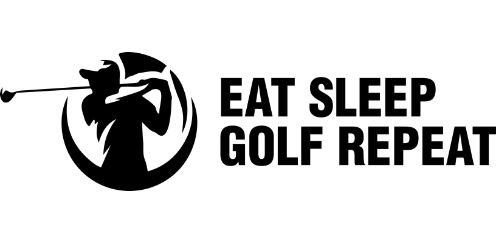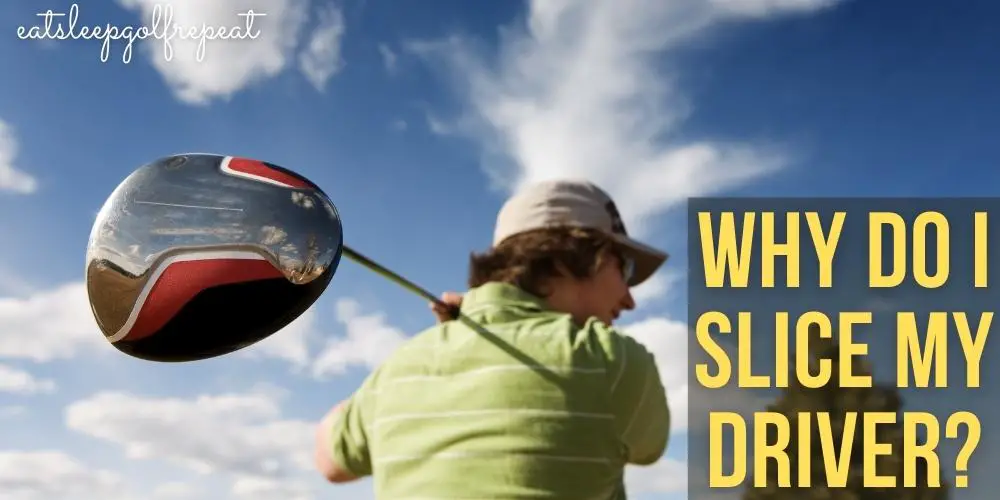
Why Do I Slice My Driver?
It is in my opinion the worst shot in golf, which many amateur golfers struggle with, the dreaded slice. This is where the ball veers dramatically from left to right during the flight, for right-handed golfers, this is reversed for left-handers.
For this article I will carry on as describing all actions for the right handed golfer, so for left handed it is just reversed.
While a left to right shot can be performed on purpose which is called a ‘fade’, and on the professional golf tours is one of the most desired golf ball flights, this is due to how controllable the golf ball is.
A Slice is typically the result of a shot that wasn’t executed as it should have been, and this can be something of a headache for a lot of golfers.
The slice is also a very hurtful shot because it is weak, and what we mean by that is you will lose a lot of distance on the golf ball.
It is also very disruptive to your game, I have seen a lot of golfers aiming so far left, out of bonds in some cases expecting the ball to slice back.
Why does the golf ball slice?
When the golf ball is struck the driver face at impact is aiming right, of your required swing path line, this does not mean you are aiming right, it is just right of where the face of the driver is hitting the golf ball.
Another reason you can slice the ball is the strike location of your golf ball on the driver face, if you can hit more towards the tow of the driver or the furthest point away from you and higher on the face as detailed below.
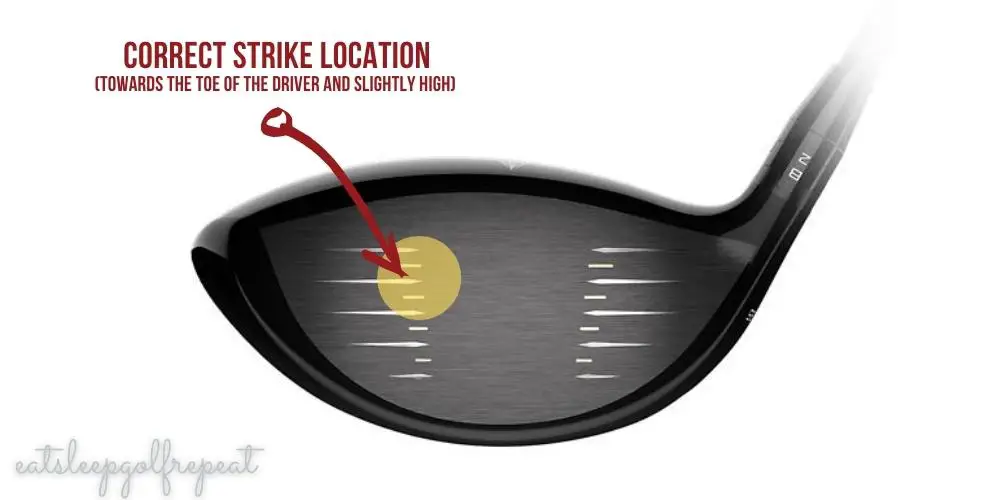
The ball will have a much better chance of staying on line, if however you hit low and towards the heal then this will create more side spin and promote a left to right shape shot or ‘slice’, as detailed below.
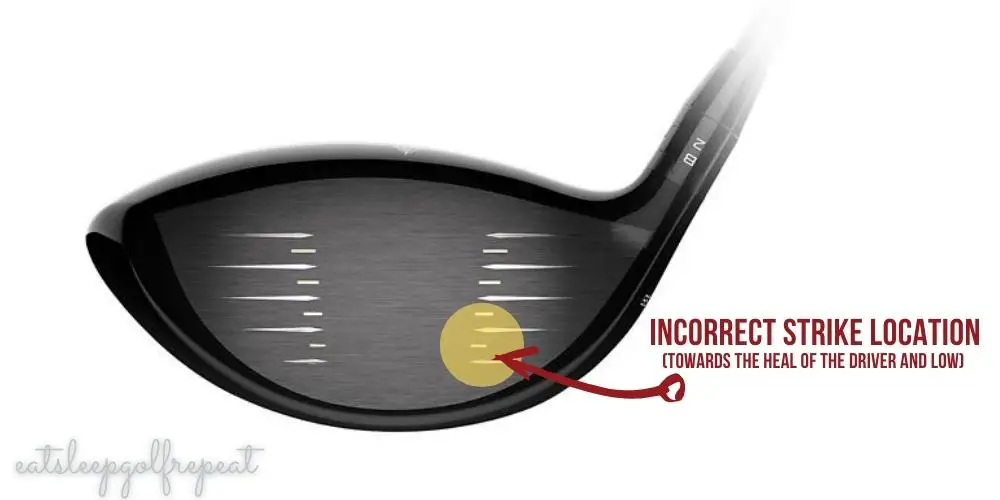
But sometimes, no matter how hard you try to change things, you just seem to keep slicing the ball, especially when using your driver, and this can be massively frustrating.
One of the best ways to tackle this problem is to understand why it is happening.
But a lot of people do not understand where they are going wrong.
In this article, we are going to be looking at what causes you to slice with a driver and how you can fix the issue.
What Causes Slice With A Driver?
Your driver is one of the most important clubs in your golf bag so it is crucial that you are able to use it to your advantage and try and hit more fairways.
Some golfers find that they always slice with their driver but their irons never seem to cause any issues or less of an issue.
This can make things even more annoying because you’re always approaching each shot in the same meticulous way, so what on earth is going wrong with your driver?
The answer lies in the equipment and isn’t actually caused by anything that you are doing. Drivers tend to have far less loft on the face of the club than all the other clubs in your golf bag and this means that there is a greater chance for the ball to curve.
The driver or ‘big stick‘ has exactly that a big stick or shaft (driver shaft is usually around 46 inches long) which also creates a greater chance for the ball to be hit incorrectly and veer from left to right.
If you would like to read an article on how important the shaft in a driver is, read it here.
It is for this simple reason that so many people seem to slice with their driver.
However, this is not the only reason that you might find you always slice your driver.
There are several things that you might be doing that are causing this problem.
- Grip
- A lack of release in the club
- Improper weight transfer
- Position of the ball
In order to prevent a slice when using your driver, these issues must be tackled and there are several things that you can do to help with this.
Let’s look at these in a little more detail.
Grip
How you grip the golf club might be affecting your slice.
In the past I have seen that just changing a golfers grip can correct a slice, this is not always the case but can have a huge impact.
It is so critical to check your grip and do not overlook this possibility.
The problem lies in a weak grip and in many cases, altering this can have a dramatic effect on the outcome of your shot.
Many people make the mistake of placing the top hand too far under the club and this means that you are unable to keep the clubface square at the point of impact.
Before you take your shot, take a look at your hands. You should be able to see two knuckles on your top hand.
If you can, this means that your grip is neutral and this will allow you to release the club at the point of impact with the ball.
When holding the grip of the club your left hand will be turned further right towards you so your knuckles come into view.
(If this feels uncomfortable then you do not worry as any change will feel strange at first.)
Releasing The Club
When we talk about releasing the club, we are talking about rotating the forearm as you move into the ball.
As you come out of the backswing, it is important to release all of the angles that were built up here including those in the wrists and elbows.
It is vital to get the timing right and as they say, ‘practice makes perfect’ but you will notice that if you do not release the club, then the hit will be led by the shoulders.
Essentially, this means that as the club face makes contact with the ball, it will be facing slightly right, resulting in the slice that will have a negative impact on both your distance, speed and accuracy.
So, what we need to be doing is on the takeaway, we are looking for a club face to be pointing more towards the ground than the sky.
This can be quite difficult to ‘feel’ and understand but is you can film your swing then it should begin to make sense.
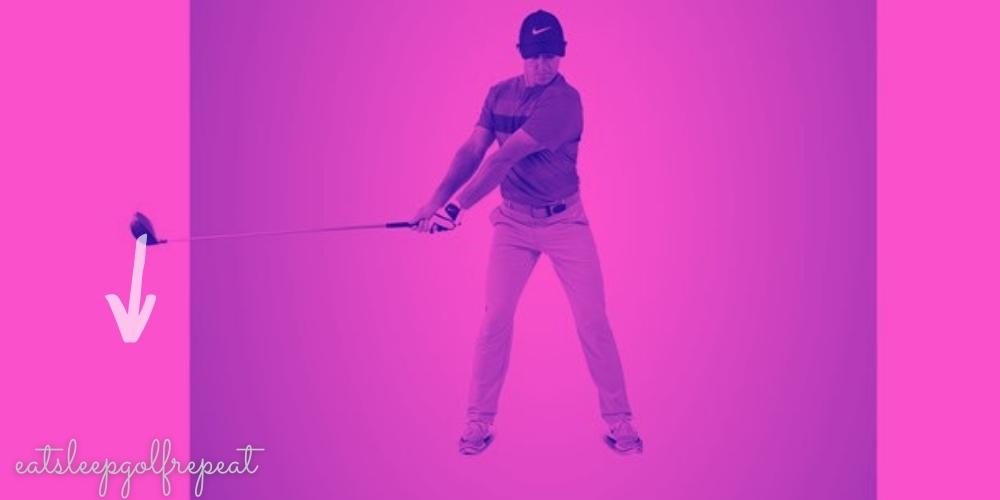
Weight Transfer
Whether you refer to this as correcting your sequencing or improving your weight transfer, it all comes back to the same point.
You are not rotating your body correctly.
Many people will get into an excellent position for taking their swing but they do not follow this through with the correct rotation and the result is almost always a slice.
It is vital that you transfer your weight down the left side if you want to avoid this.
One of the best ways to address this is to place your golf bag so that it is touching your leg before you start your back swing.
As you begin the take away and bring it back down, your leg should move away from the golf bag but then return to it.
Ball Position
It may surprise you to learn that the position of the ball could be causing the problem.
All too often, we place our attention on our technique and the way that we handle the club when the issue could be entirely outside of this.
If your ball is placed too far forwards in your stance, it will behave differently when you bring the club down onto it, potentially causing it to fly off in a direction that you did not intend. This is because, when the ball is too far forward, you will be swinging down across it as the result of an outside swing path.
The best way to address this problem is to put the driver just inside the left heel. You will likely notice that by doing this check before each swing, your slice will disappear.
Do Draw Drivers Fix A Slice?
One thing that has been discussed a lot recently is whether using a draw-bias driver will help to correct your slice.
In short, the equipment that you are using can only do so much.
The best way to get rid of a slice and tackle any other golfing problems is to take golf lessons with a professional who can teach you how to execute each shot perfectly.
However, in modern times, not all of us have the time to be dedicating to golf lessons.
A draw biased driver is a viable alternative to being taught by a pro but you won’t ever get the same result.
This is more of a quick-fix as these clubs are designed to give less side spin at the point of impact with the ball so they can certainly help to improve a slice.
Draw drivers work using weights inside the club head that move around and this can alter the centre of gravity.
There have been several tests done on whether this is effective and the results are conclusive, it does make a difference.
I have actually purchased a draw biased driver for my Dad, how had a really bad slice, and it has really helped him.
If you are new to golf and have been struggling with a slice, this might be the way forward but we would also recommend working on your technique as well to improve your golf over the long term.
If you want a little bit of fun, you can also buy a golf ball that will not slice, it is not legal in competitions but great for fun. Read our article here Best Golf Ball To Cure a Slice or Hook.
Setting Up For A Slice-Free Swing
Now that we understand the importance of technique when trying to avoid a slice, let’s take a look at some quick setup steps to make sure that you never have that irritating curvature again.
● Take the grip in the left hand and aim to place the majority of the grip into the fingers on this hand.
You should be able to see at least two knuckles, but if your slice is very bad, you might aim to see three.
The V shape in between your index finger and thumb needs to point at the right shoulder.
● Now place your right hand onto the grip in a complimentary fashion, under the left hand so that the V points towards the left shoulder.
● Place the ball on the inside of the foot, roughly in line with your heel.
● With your hands in the correct position and your head behind the ball, you will be in the optimal position for the shoulders to tilt which will mean that they are better able to rotate.
● Now swing the club back to the point where your left shoulder comes under the chin.
● As you swing the club down, you should stay on an outside-in path and as you come down to impact, rotate the outer edge of the club over its heel.
This will ensure that the flight is straight.
Conclusion
Slicing a driver is one of the main gripes of golfers, especially those who are new to the sport.
But fortunately, this is typically a problem that is easily fixed. In some cases, the issue can be with the type of club you are using and trying a draw driver might help.
However, there is no substitute for working on your technique and you will likely find that once you improve your grip and your swing, your slice will disappear forever.
